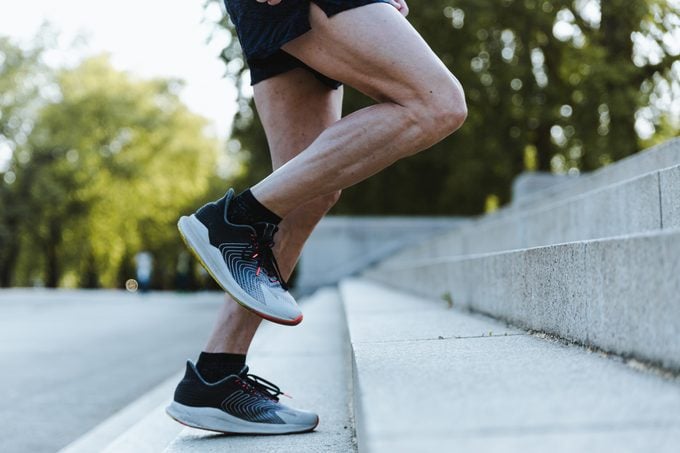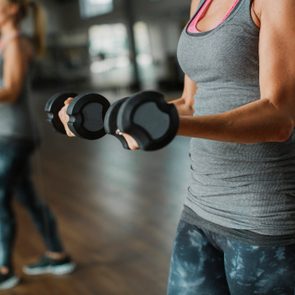4 Signs You Have a Muscle Imbalance—and How to Fix It
Updated: Jun. 02, 2021
If you're experiencing aches and pains from repetitive movements, you may have a muscle imbalance. Here are the signs and how to fix it.
What’s a muscle imbalance?
If you’re suffering from nagging aches and pains (or worse, an outright injury), in all likelihood, you’re also suffering from muscle imbalances. The concept is fairly straightforward.
“A muscle imbalance is usually referring to disproportionate strength somewhere in the body,” says Steve Yoon, MD, physiatrist and director of The Regenerative Sports and Joint Clinic at Cedars-Sinai Kerlan-Jobe Institute in Los Angeles.
“This is significant because if there’s more strength in one muscle than another, it can put additional stress on different parts of the body during activity, potentially causing injury,” says Dr. Yoon, who is also the lead team physician for the Los Angeles Clippers and team physician for the Los Angeles Angels.
Why muscle imbalances are a problem
Of course, your body is made up of hundreds of muscles, and none of these muscles works completely independently. They’re all part of a kinetic chain that facilitates coordinated movement.
Some muscle groups are larger and stronger than others by design—for instance, your quadriceps are larger and stronger than, say, your biceps—so the very nature of an imbalance of strength between these two muscle groups is both intended and important for normal, day-to-day movement.
That’s not the type of imbalance we’re referring to.
Rather, we’re referring to imbalances that cross a joint or joints, and affect movement patterns as a result.
“These muscle imbalances can be due to strength, power, endurance, or flexibility, ” says Lauren Polivka, physical therapist, holistic health coach, and founder of Repair Perform Recover in Atlanta. And they can pop up for all sorts of reasons, whether from an old injury, lifestyle habits, differences in limb length, poor exercise training programs, or basic bad posture.
When muscles that are intended to work in conjunction to perform regular movement become affected by an imbalance, that’s when pain and injuries tend to occur. These imbalances can be side-to-side, as when one leg or arm is stronger than the other, or they can be agonist/antagonist imbalances on the opposite side of a joint.
“An example of this would be if a person is excessively strong in the quadriceps muscles versus the hamstring muscles in the leg,” says Dr. Yoon. “With repetitive walking, jogging, or running, excessive muscle strength in the front of the leg can lead to excessive force or load on the front of the knee.”
(Try these hamstring exercises you can do at home.)
Side-to-side muscle imbalances
If you picked up a baseball and tried to throw it with your right arm as far as you could, then tried to throw it with your left arm as far as you could, you’d probably notice one arm was stronger than the other. The same could be said for your legs if you tried to kick a soccer ball.
Most people have a dominant side, and because one side of their body is stronger, they also tend to favor that side in day-to-day life and athletic endeavors. This doesn’t always cause obvious problems, but if one side is favored excessively, it could result in injuries.
“If someone has sprained their ankle in the past and now the muscles of the ankle are stiff and weak compared to the other side, activities like jumping could favor the more flexible and stronger body part,” says Polivka. “This can lead to repetitive, overuse injuries like tendonitis, and over time, cause degenerative processes like arthritis to develop more quickly.”
In addition to past or present injuries, some athletic activities lend themselves to overuse injuries to one side of the body, while side-to-side biomechanical differences can also play a role. For instance, a baseball pitcher is going to develop more strength and power to one side of the body than the other and is going to overuse one arm much more than the other.
Likewise, if a competitive runner has one leg that’s longer than the other, one side of the body will constantly be placing more force and stress on the longer leg, leading to side-to-side differences in muscle strength and power.
(Suffering from shin splints as a runner? Here’s how to avoid them.)
Agonist/antagonist muscle imbalances
Your major muscle groups are set up in agonist and antagonist roles, and you can usually identify which muscles are set up like this by identifying which muscles are on the opposite sides of a limb.
For instance, your quadriceps and hamstrings (the front and back of your thighs) are agonists and antagonists to the other. Likewise, your biceps and triceps, your gastrocnemius, and your anterior tibialis (your calf and your shin) are also agonists and antagonists.
(Got tight calves? Try these calf stretches.)
The agonist is the muscle that, for any given movement, is the “primary mover,” while the antagonist must relax to allow the movement. So when you’re doing a quadriceps extension, the quads are contracting to extend your knees (the agonists), while the hamstrings have to relax to allow your knees to extend (the antagonists).
And conversely, when you’re doing a hamstring curl, the hamstrings are contracting to bend and flex the knees (the agonists), while the quads are relaxing to allow the knees to flex (the antagonists).
When muscle groups work together in coordination like this, ultimately they’re responsible for providing stabilization to the joints they support. When one muscle group is stronger than the other, or when one muscle has shortened or weakened due to injuries or disuse, joint pain and injuries can arise when performing regular exercises or going through day-to-day motions.
“Squatting, for instance, requires the quadriceps and hamstrings to work together to stabilize the knee and create power, but overuse of the quadriceps and underuse of the hamstrings can lead to poor movement patterns, inefficient patterns, and injuries,” explains Polivka.

Signs you have a muscle imbalance
Dr. Yoon emphasizes that the only way to know for sure if you have an imbalance is to talk to a physical therapist, kinesiotherapist, or orthopedist to be tested. This is particularly important if you’re experiencing pain or movement limitations that are interfering with your favorite activities, hobbies, or day-to-day life.
That said, there are some signs you might be experiencing an imbalance. Consider the following indicators.
Your training is one-dimensional
If you’re a diehard runner who only runs, you might have an imbalance. Likewise, if you hit the gym regularly, but focus most on targeting the “show me muscles” of the front half of your body to the detriment of the back half of your body (you do more “pushing” exercises like bench press than “pulling” exercises like dumbbell rows), you might have an imbalance.
(Work on your “pulling” muscles with these back exercises.)
One-dimensional training is incredibly common, but can also be incredibly detrimental, as it specifically strengthens the agonists responsible for one type of movement while failing to strengthen those designed for the opposing movement.
The key to a high-quality training program is balance. For the average person, a solid program should target all the major muscle groups equally, not favoring one group in reps or sets over its opposing group. For instance, it shouldn’t include excessive quad-focused exercises like squats, lunges, quadriceps extensions, and box jumps without including an equal measure of hamstring-focused exercises like deadlifts, good mornings, and hamstring curls.
Your program should also include cross-training that switches up your movement patterns so you’re exercising in all three planes of motion. For instance, runners and cyclists are constantly moving in a forward-charging pattern in the sagittal plane of motion, but rarely engage in side-to-side movements in the frontal plane, or twisting or horizontal flexion or extension in the transverse plane of motion. For these reasons, cross-training for runners should include exercises like yoga, side lunges or banded lateral steps, and core work.
(Try monster walks to add lateral movement to your workout.)
Consult with a certified personal trainer and ask them to craft a balanced program or cross-training program to help you address and correct potential weaknesses.
When to hold off correcting muscle imbalances
If you’re training for a major athletic event that requires greater strength on one side of your body than the other, it’s prudent to hold off on correcting imbalances until after the event. Golfers, tennis players, baseball players, and even kickers in football are all prime examples.
“Some imbalances are part of sport,” explains James de Lacey, a professional strength and conditioning coach for the international Rugby Union and Rugby League and an exercise and sport science published researcher.
“In fact, reducing an imbalance may be problematic to an athlete who is performing in a competition soon. It may be better to leave the asymmetry due to the potential of altering motor control with the athlete having to integrate new levels of power into their technique.”
For instance, de Lacey cites 2018 research published in the Strength and Conditioning Journal that found correcting or reducing an upper-body imbalance in baseball pitchers appeared to reduce the pitchers’ throwing velocity.
You have poor posture
If you’re constantly looking down at your phone or computer, or you slouch on the couch as soon as you get home from work (or if you have poor posture while sitting at your desk all day), then your poor posture is quite likely causing muscle imbalances.
“Poor posture is one of the chronic factors that’s leading to injuries and pain in the non-elite athlete population,” says Polivka.
“The hours spent sitting and staring at a screen are limiting their performance in sports or fitness, and they usually don’t know how much it impacts them until they experience an injury.”
She explains that this is because the sitting posture that dominates most people’s lives often leads to stiff necks, shoulders, backs, ankles, and weakness in the upper back, abdominals, glutes, and knees.
The first way to correct it? Notice it. “The awareness usually makes the biggest change,” says Polivka. “When I talk to clients and educate them about their imbalances, they often haven’t noticed the effects before, when they should be able to identify the signs.”
Set an alarm on your phone twice an hour and when it goes off, check your posture—are you slumped forward? Are your shoulders rounded? Are you looking down? Use this as an opportunity to stand up and walk around, resetting your shoulders by stretching your chest, looking up, and activating the muscles of your neck, back, and glutes.
And if you’re experiencing pain, particularly in your upper back or neck, it’s worthwhile to incorporate exercises daily that are designed to strengthen the back and stretch the chest and shoulders. Options like book openers, I-Y-Ts, and bird dogs are a good place to start.
Your unilateral movements are unequally yoked
Posture isn’t the only area you need to exercise awareness. There are simple ways to notice side-to-side imbalances by paying attention to how you move throughout the day. Polivka suggests the following questions as a way to start tuning into your own movements:
-
Can you bring your arm up your back farther with your right or left arm? (With your elbow bent, as though reaching up from behind to scratch between your shoulder blades.)
-
Can you balance equally on one leg versus the other leg?
-
Does a lunge on your right leg feel different than the left leg? (For instance, are you more wobbly lunging to one side, or do you feel movement limitations or pain on one side compared to the other?)
-
Do you always cross one leg over the other when sitting down?
If you’ve identified a particular muscle group or movement that is clearly unequal, it’s time to talk to a trainer or physical therapist to help you correct the issue with balance exercises.
“Focus on fitness methods and training that work on unilateral strength and mobility, meaning isolating one side of the body from the other,” Polivka says. “These include movements like lunging, split squats, single-arm dumbbell, or kettlebell work. This will not only expose the imbalances so you can assess your progress but will also help build better mobility in the movements.”
You’re experiencing pain
People experience pain all the time for a number of reasons, but what if you’re experiencing pain that you can’t track to a specific injury? Or if you’ve been working out for a while and you start noticing the types of aches and pains that are associated with “overuse” at your knees, hips, or ankles? Then there’s likely a muscle imbalance at play.
That doesn’t mean a muscle imbalance is the sole contributing factor, but it’s likely not helping.
The thing is, if you’re experiencing pain, it’s time to head to a doctor or physical therapist to get a movement assessment. Trying to correct imbalances on your own when you don’t know exactly which muscles are out of whack (or why) could be like using a garden hose to put out a four-alarm fire.
Ask for a movement analysis and work with a licensed therapist to come up with a plan to correct the problems they uncover.
“The journey to overcoming imbalances is just that… a journey,” says Polivka. “It takes time and patience and discipline. And just when you feel your imbalances have gone away, you still have to add in training or stretching that continuously works on it.”
That said, if you’re working towards correcting a specific imbalance, you can expect the process to take at least a few months, if not longer, with consistent and persistent training and postural correction.




















